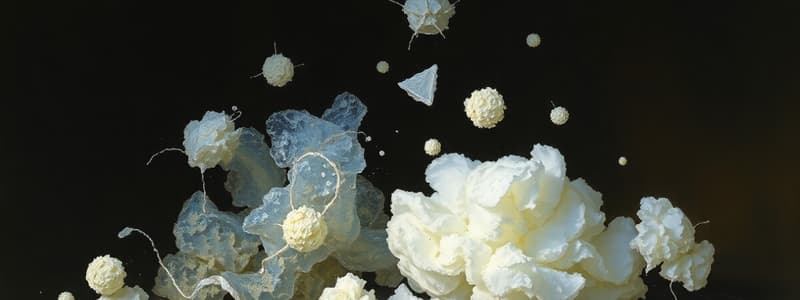Podcast
Questions and Answers
What is the main purpose of a plant's roots?
What is the main purpose of a plant's roots?
- To make food for the plant
- To attract animals
- To absorb water and nutrients from the soil (correct)
- To support the plant above ground
All plants produce flowers.
All plants produce flowers.
False (B)
Name one animal that has a backbone.
Name one animal that has a backbone.
A dog
A __________ is a structure that provides support and shape to a plant.
A __________ is a structure that provides support and shape to a plant.
Match the following animals with their characteristics:
Match the following animals with their characteristics:
Flashcards
Science Curriculum
Science Curriculum
A set of learning standards and expectations for science in Ontario Grade 3.
Grade 3 Science
Grade 3 Science
The science topics studied in Grade 3 in Ontario.
Learning Standards
Learning Standards
Clear expectations for what students should know and be able to do in science.
Science Unit
Science Unit
Signup and view all the flashcards
Ontario Curriculum
Ontario Curriculum
Signup and view all the flashcards
Study Notes
Quiz Questions
- What are the three states of matter?
- How do you change water from a liquid to a gas?
- What is the difference between a solid and a liquid?
- Name two things that can dissolve in water.
- What happens when you mix baking soda and vinegar?
- What is a mixture? Give an example.
- What is a solution? Give an example.
- Explain how different materials are different based on properties.
- Describe a physical change. Give an example.
- Can you identify the different materials in a mixture?
- Describe the different ways matter can change, such as freezing, melting, boiling, and dissolving.
Study Notes: Ontario Grade 3 Science - Structures Unit
-
States of Matter: Matter exists in three states: solid, liquid, and gas.
- Solids have a definite shape and volume. Examples include rocks, wood, and ice.
- Liquids have a definite volume but take the shape of their container. Examples include water, juice, and milk.
- Gases have no definite shape or volume and fill their container completely. Examples include air, steam, and oxygen.
-
Changes of State: Matter can change from one state to another.
- Melting: Changing from a solid to a liquid (e.g., ice melting into water).
- Freezing: Changing from a liquid to a solid (e.g., water freezing into ice).
- Boiling: Changing from a liquid to a gas (e.g., water boiling into steam or water vapor).
- Condensation: Changing from a gas to a liquid (e.g., water vapor turning into rain or dew).
-
Properties of Matter: Matter has different properties that help us describe it. Examples include color, shape, size, texture, hardness, and flexibility.
- Mass: The amount of matter in an object.
- Volume: The amount of space an object takes up.
-
Mixtures and Solutions: Mixtures are combinations of two or more substances that are not chemically combined.
- Mixtures can be separated by physical methods like sorting.
- Solutions are special mixtures where one substance dissolves completely into another. Examples include salt dissolving in water or sugar dissolving in water.
-
Physical Changes: A physical change alters the form of a substance but does not change its chemical composition.
- Examples include tearing a piece of paper, bending a wire, melting ice, and dissolving sugar.
- These changes do not create a new substance.
-
Separating Mixtures: Physical methods can be used to separate different substances in a mixture, such as using a sieve, magnet, or evaporation.
- Filtration separates solids from liquids.
- Evaporation separates a solid dissolved in a liquid by heating the solution to allow the liquid to boil and be removed.
-
Important Concepts:
- Matter is anything that takes up space and has mass.
- Materials are different kinds of matter, and their properties make them suitable for certain uses.
- Changes in temperature directly affect the state of matter.
- Understanding the different states of matter is crucial for many sciences and everyday activities.
-
Activity Examples:
- Observing different materials changing states or being mixed.
- Identifying the materials in a mixture.
- Experimenting with heating or cooling substances to see how states change.
- Separating mixtures.
Additional Notes
- Emphasize hands-on activities and observations as critical for learning and understanding these concepts.
- Make connections to real-world examples and encourage students' curiosity about the properties of matter.
- Encourage the use of vocabulary related to these concepts, including terms like solid, liquid, gas, mixture, solution, physical change, and properties.
- Using visuals like diagrams, charts, and demonstrations helps to illustrate the concepts effectively.
Studying That Suits You
Use AI to generate personalized quizzes and flashcards to suit your learning preferences.




